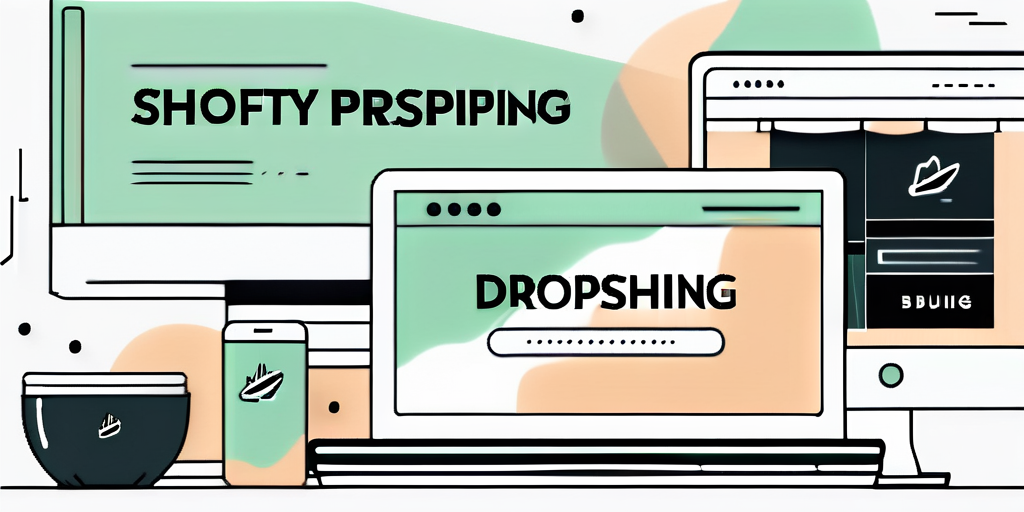In this comprehensive guide, we will take you through everything you need to know about Shopify dropshipping. From understanding the basics of dropshipping to setting up your Shopify store and managing your business, we’ve got you covered. So let’s dive in and learn how to run a successful dropshipping business on Shopify.
Understanding the Basics of Dropshipping
In order to succeed in dropshipping, it’s important to have a clear understanding of what it is and how it works. Dropshipping is a business model where you sell products without having to hold any inventory. Instead, when a customer places an order on your online store, you simply purchase the product from a third-party supplier who then ships it directly to the customer. This means you don’t have to worry about warehousing, packaging, or shipping the products yourself.

Defining Dropshipping
Dropshipping is a popular business model because it offers a low-cost way to start an online store. You don’t have to invest in inventory upfront, which means you can easily test different products and niches without financial risk. Additionally, dropshipping allows you to run your business from anywhere in the world as long as you have an internet connection.
The Role of Shopify in Dropshipping
Shopify is an all-in-one e-commerce platform that makes it easy to start, run, and grow your dropshipping business. With Shopify, you can create an online store, manage your products and inventory, process orders, and track sales – all from one place. It provides a user-friendly interface and a wide range of customizable themes and apps that help you create a professional and high-converting online store.
One of the key advantages of using Shopify for dropshipping is its seamless integration with various third-party apps and services. These integrations allow you to automate various aspects of your business, such as order fulfillment and inventory management. For example, you can connect your Shopify store to a fulfillment service that will handle the packaging and shipping of your products, saving you time and effort.
Furthermore, Shopify offers a range of marketing tools and features to help you attract and retain customers. From customizable discount codes and abandoned cart recovery to email marketing and social media integration, Shopify provides you with the tools you need to drive traffic and increase sales for your dropshipping business.
Setting Up Your Shopify Dropshipping Store
Now that you understand the basics of dropshipping, it’s time to set up your Shopify store. Here are the key steps you need to follow:

Choosing Your Niche
The success of your dropshipping business largely depends on choosing the right niche. A niche is a specific segment of the market that you will target with your products. It’s important to choose a niche that you are passionate about and that has enough demand to sustain your business. Conduct thorough market research to identify profitable niches and evaluate the competition before making a decision.
Let’s say you’re interested in starting a dropshipping business in the fitness industry. You might consider focusing on a niche within this market, such as yoga equipment or fitness apparel for women. By narrowing down your niche, you can tailor your product offerings and marketing strategies to better meet the needs of your target audience.
When conducting market research, take the time to analyze trends, identify customer pain points, and understand the purchasing behavior of your potential customers. This information will help you make informed decisions when selecting products to sell and creating a compelling brand story.
Setting Up Your Shopify Account
Once you’ve chosen your niche, sign up for a Shopify account. Shopify offers different pricing plans depending on your needs and budget. After signing up, you can start customizing your store by selecting a theme, uploading your logo, and adding products to your inventory.
When customizing your store, it’s important to create a visually appealing and user-friendly website. Choose a theme that aligns with your brand and showcases your products in the best possible way. Upload high-quality product images and write compelling product descriptions to entice potential customers.
Consider implementing additional features on your Shopify store, such as customer reviews, live chat support, and social media integration. These features can enhance the overall shopping experience for your customers and help build trust in your brand.
Selecting Your Dropshipping Suppliers
Choosing reliable dropshipping suppliers is crucial to ensure smooth order fulfillment and customer satisfaction. Look for suppliers with a good track record, competitive prices, and a wide range of products. Additionally, consider suppliers that offer fast shipping options to improve customer experience. With Shopify, you can easily connect with suppliers through apps and marketplaces to streamline your supplier selection process.
When evaluating potential suppliers, take into account their reputation within the industry. Read reviews and testimonials from other dropshippers to get a sense of their reliability and customer service. It’s also important to consider the quality of their products and their ability to handle returns or exchanges efficiently.
Furthermore, don’t hesitate to reach out to suppliers directly to discuss their terms and conditions, shipping times, and any other concerns you may have. Building a strong relationship with your suppliers is key to establishing a successful dropshipping business.
Optimizing Your Shopify Store for Success
Now that your Shopify dropshipping store is set up, it’s important to optimize it for success. Here are some key strategies:

Designing Your Shopify Store
A visually appealing and user-friendly store design can significantly impact your conversion rates. Customize your store’s theme to create a professional and consistent brand image. Use high-quality product images, clear product descriptions, and customer reviews to build trust and persuade visitors to make a purchase.
When designing your Shopify store, it’s important to consider the overall user experience. Think about how your customers will navigate through your website and make sure the layout is intuitive and easy to use. You can also consider adding interactive elements, such as product videos or virtual try-on features, to enhance the shopping experience and increase customer engagement.
Furthermore, don’t underestimate the power of color psychology in your store’s design. Different colors evoke different emotions and can influence customer behavior. For example, using warm colors like red or orange can create a sense of urgency and encourage impulse purchases, while cool colors like blue or green can promote a feeling of trust and relaxation.
Product Listing Best Practices
When listing your products, focus on providing accurate and detailed information. Use descriptive and SEO-friendly product titles and descriptions to improve your store’s visibility in search engine results. Organize your products into logical categories and use tags to make it easy for customers to navigate your store.
In addition to these best practices, consider implementing product recommendations or related product sections on your product pages. This can help customers discover additional items they may be interested in, increasing the chances of cross-selling and upselling.
Another effective strategy is to leverage user-generated content. Encourage customers to leave reviews and ratings for the products they’ve purchased. This not only provides valuable social proof but also helps build a community around your brand. You can even showcase these reviews on your product pages to further boost customer trust and confidence in your products.
Implementing SEO Strategies
Search Engine Optimization (SEO) is crucial to drive organic traffic to your Shopify store. Optimize your store’s pages, URLs, and meta tags with relevant keywords. Create valuable content through a blog to attract and engage your target audience. Additionally, build high-quality backlinks to improve your store’s authority and visibility in search engine rankings.
When it comes to SEO, it’s important to stay up to date with the latest trends and algorithms. Regularly conduct keyword research to identify new opportunities and optimize your content accordingly. Keep an eye on your competitors and analyze their SEO strategies to stay ahead of the game.
Furthermore, don’t forget about the power of social media in driving traffic to your store. Implement social sharing buttons on your product pages to encourage customers to share your products with their networks. Engage with your audience on social media platforms and build a strong online presence to increase brand awareness and attract potential customers.
Managing Your Shopify Dropshipping Business
Running a successful dropshipping business requires effective management. Here are some key aspects to consider:
Handling Orders and Inventory
When an order is placed on your Shopify store, it’s important to promptly process it with your supplier. Make sure you have a reliable system in place to track inventory levels and automatically update your store when products become out of stock. This helps prevent delays and ensures a smooth order fulfillment process.
Customer Service in Dropshipping
Providing excellent customer service is critical for the success of your dropshipping business. Respond promptly to customer inquiries and address any issues or concerns they may have. Building strong relationships with your customers can lead to repeat purchases and positive reviews, which ultimately helps grow your business.
Dealing with Returns and Refunds
Inevitably, you may encounter situations where a customer wants to return a product or request a refund. Have a clear and fair return policy in place to handle such situations. Communicate the policy clearly to your customers and ensure a smooth return/refund process. This helps build trust and maintain a positive reputation for your business.
By following these steps and implementing the strategies outlined above, you’ll be well on your way to running a successful dropshipping business with Shopify. Remember to continuously learn and adapt as the e-commerce landscape evolves. Good luck!
